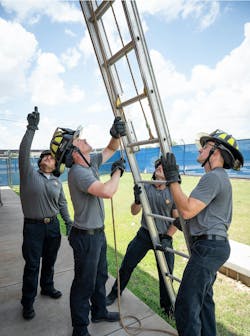Learning through teaching can have a two-fold benefit. Members can improve their knowledge and skill retention, and fire officers can empower their members to teach in the firehouse when opportunities present themselves.
Docendo discimus
By no means is the concept of teaching as a way to improve learning a new one. The stoic philosopher Seneca the Younger often is credited with the Latin phrase “docendo discimus,” which can be translated to “by teaching, we learn.”
Further, surgical training has used the technique to teach students since the late 1800s. The three-step instructional method that was introduced at that time, “see one, do one, teach one,” still is used in the medical field.
The “see one, do one, teach one” process first has an instructor (expert) instructing a student (novice) on a new skill. During the “see one” part of the instruction, the student witnesses the skill as modeled by the instructor.
In the second part—“do one”—the student performs the skill, with the instructor serving as a coach/mentor and overseeing the procedure and offering feedback. The student may “do one” a few times to ensure competence. As part of the progression, the student becomes more independent.
The third part—“teach one”—calls for the student to step up and instruct. Of course, the individual isn’t teaching this to new learners as an expert but teaching it back to the instructor, who gauges whether learning occurred. Being placed into the role of teacher improves the student’s knowledge and competence levels.
The protégé effect, a plastic platypus and a rubber duck
There is a researched, positive difference in the learning effect when people learn for the purpose of teaching others versus learning for themselves. Research on learning and knowledge retention indicates that the acts of teaching, preparing to teach, and even pretending to teach can enhance and improve knowledge acquisition.
As explained by Harry Cloke in “The Protégé Effect: How to Learn by Teaching” (Growth Engineering, April 29, 2024), the notion that “we learn more effectively by teaching information to others, ” or the protégé effect, is a concept that simply suggests that we can learn more effectively when we are placed into the role of teaching information to other people. In practice, this effect has shown to be beneficial in three separate situations: when actually teaching, when preparing or expecting to teach, and when pretending to teach.
Learning by teaching
Teaching a subject requires a person who is doing the teaching to think about the information and skills to be taught. The instructor takes the time and effort to consider the learners and the best way to get the information across and to organize the materials and the learning process in a manner that supports recall. Each of these steps has the person who is doing the teaching interacting with the information on a deeper level than one who simply is learning the information for him/herself. It’s necessary for the teacher to be more aware of the materials, to move past reiterating the “what” of the information, and to be able to explain and describe the “how” and the “why.”
Learning by expecting to teach
In “The relative benefits of learning by teaching and teaching expectancy” (Logan Fiorella and Richard Mayer, Contemporary Educational Psychology, Volume 38, Issue 4), the authors state that not only does the act of teaching improve learning but simply expecting or preparing to teach fosters comprehension and enhances learning.
Researchers designed experiments that were guided by the question, “Does having an expectancy to teach enhance learning?” They experimented with two groups. Members of one group were asked to learn the material for a test; the members of the other group were tasked with learning the material as if they would teach it later. The members of the learning-to-teach group had better results than the members of the learning-for-the-test group, which supports the claim that expecting to teach enhances individual learning.
Learning by pretending to teach
A third interesting component from the teaching-as-learning research is that pretending to teach—even “teaching” inanimate objects—also was shown to influence developing and retaining knowledge.
There is a method of studying where one “teaches” what was learned aloud to an inanimate object (e.g., a toy plastic platypus). This act of teaching back, termed plastic platypus learning, was found to enhance retention. The effectiveness of this process even was immortalized in the code developer world as “rubber duck debugging,” where the developer explains each step aloud to a rubber duck to help to think through the process and find flaws.
Why you should teach to learn
Knowing the effect of teaching on learning, you have two considerations. First, consider the practice of preparing and pretending to teach as methods of your learning when you want to understand a topic more in depth. Second, find opportunities to teach to improve your knowledge and skills.
The effort that you put into digging deeper into the training materials can highlight the gaps in what you currently know. This process might cause you to grapple and seek deeper understanding to support or refute your current knowledge.
When we grapple with ideas and concepts, we move past surface learning and begin to understand the material at a deeper level. An example of the benefit of preparing to teach is the examination of something that you held as true since you first heard it as student, but when faced with the prospect of delivering this knowledge to other people, you dig deeper into the origins of the claim to find out it isn’t as you thought or must be examined further. This process of discovery is a hallmark of developing expertise on a subject.
Learning-as-teaching considerations
Organize the material to be taught in a way that makes sense to you. This process enables you to find a flow to the material that will resonate with you and the people who are expected to learn.
Think about the material and “translate” it into a language that you and your crew use. You know the local terminology. Expend the effort to put it into words that make sense to all participants.
Create a problem to solve. Move past memorizing facts and figures and approach a fire service training issue in a different way. Creating a problem forces you to grapple with various aspects of the issue and might produce a novel way of addressing the training session.
Explain like I’m 5 years old. I stole this strategy from social media terminology. This isn’t meant to be insulting to the learners. A trait of good instructors is that they can take a complex subject and faithfully break it down in a manner that is understandable to their audience.
Anticipate questions that the student might ask. By predicting questions that the learners might pose, you must search further into the materials and examine the concepts and controversies around the topic. As an instructor, this process affords you a deeper understanding of the training materials.
Get feedback. Ask for constructive feedback from supervisors and the people who you teach. The feedback that you receive serves to highlight the good practices while also giving routes toward improvement. Although sometimes it might sting to hear feedback regarding what you can do better, it’s a vital process to improve your instructional practices.
Officers: Empower your people to teach
When you ask a firefighter to teach, it might seem like you are diminishing your supervisory role as a fire officer and instructor. However, you still are the officer and instructor. Instead of being the presenter of information, you place yourself into a mentoring and coaching role. Your guidance is vital to help the firefighter who is instructing as that individual works through his/her preparations, delivery and feedback phases.
There are numerous opportunities for the fire officer to empower a motivated firefighter to teach in both one-on-one situations and in group scenarios in the firehouse setting. These scenarios include a firefighter explaining pump procedures to a new firefighter and instructing the crew on a new piece of equipment. There is evidence that peer teaching—being taught by someone who is in a comparable situation versus by a person who is in a supervisory role—is more beneficial.
This said, don’t force members into situations that will make them anxious. Ensure that they are ready for the responsibility and look for opportunities to align the firefighter’s strengths with the training session or drill topic.
Multiple benefits
Learning through teaching has benefits for both the individual firefighter and the organization. For individuals who prepare to instruct, the practices of preparing to teach and delivering instruction can deepen understanding of fire and emergency service topics. For officers, encouraging firefighters to step up and teach develops a more knowledgeable and better trained cadre of employees.
About the Author

Edward Tracey
Edward A. Tracey, Ed.D., is a 30-year member of the fire service who has served the past 20 years with the Rochester, NY, Fire Department. He serves as the Rescue Co. captain, including additional responsibilities tied to collaborative management of the department’s technical rescue training, response and typing programs. Tracey also serves as a fire service and technical rescue instructor for a statewide training system, sits on numerous curriculum development committees and serves as an adjunct professor. He has a doctoral degree in education from the University of Rochester, a master’s degree in public administration from SUNY Brockport and a bachelor’s degree in fire service administration from the University of New Haven.
